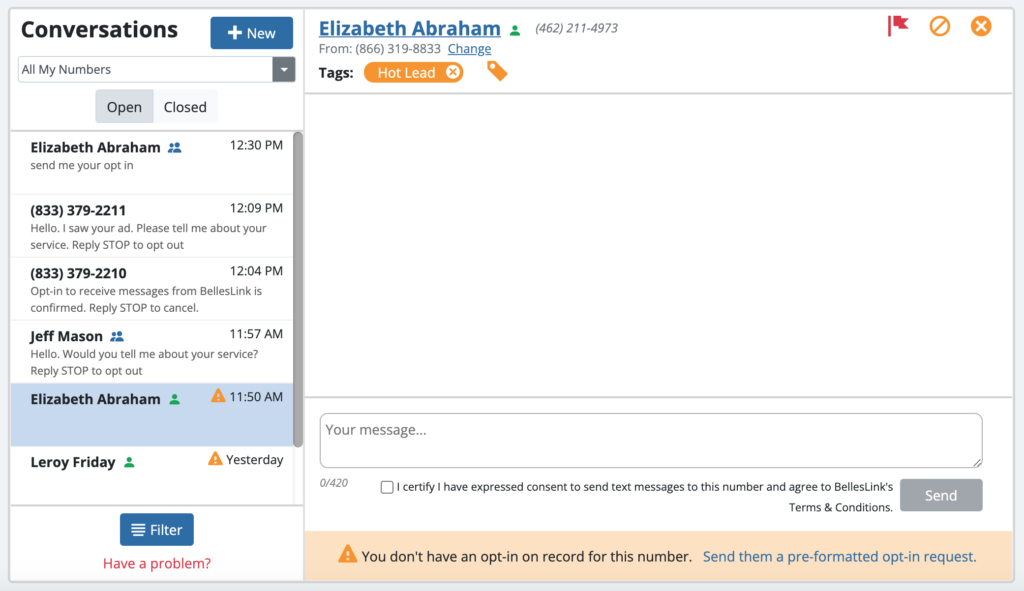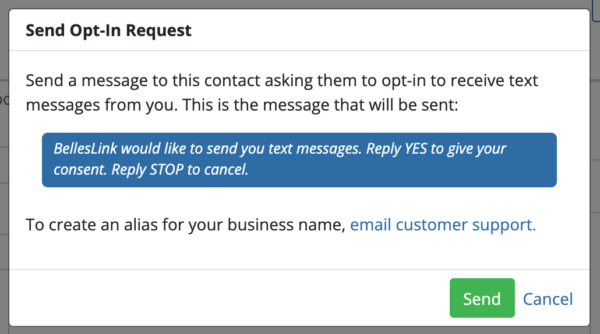How do you get an opt-in from your customers for text messaging? Getting an opt-in is important, but it is not complicated. You can get the “express written consent” needed for compliance when the conversation starts by phone, text, or face-to-face.
In this webinar BellesLink product manager, Jeff Mason, talks about the three types of opt-in consent and how to use BellesLink’s built-in opt-in request feature to get express written consent for full texting compliance.
What is a text messaging opt-in?
Opting in to receive text messages from your business means your customer has given you consent to text them. There are three levels of consent. Express written consent is the highest level and it’s what is required for compliance.
According to the Telephone Consumer Protection Act (TCPA), customers must give businesses “express written consent” before the business sends them automated promotional text messages. This written consent can’t be buried in a pages-long form full of legalese. It must be clear and conspicuous, so the recipient knows what they’re signing up for. Commonly, express written consent is given on a website form or in response to an opt-in request text message.
Who requires a text messaging opt-in?
Federal and state regulatory agencies require businesses to get consent before they text people for informational or promotional purposes. The fines for ignoring these regulations are steep. In 2012 Papa John’s agreed to pay over $16 million to settle a class action lawsuit brought against them for failure to get proper customer consent. So, as a business, you need to under the risks of non-compliant texting and how to operate within best practices.
Telecommunication industry groups define best practices for business text messaging, which is also known as A2P, or application to person, messaging. The texting you do with family and friends is called P2P, or person to person, texting.
- Federal Communications Commission (FCC) – the regulators
- Federal Trade Commission (FTC) – the enforcers
- Telephone Consumer Protection Act (TCPA) – the Federal legislation
- Cellular Telecommunications Industry Association (CTIA) – the best-practices industry group
Text messaging best-practices
Most text messaging best-practices deal with how and when a business needs to get consent from their customer before texting them. One rule is technical.
Telecommunication carriers want business texts, A2P messages, to be sent on toll-free phone numbers, not local numbers. This allows them to more easily monitor for compliance.
Texting in the BellesLink platform requires a toll-free number. This insures that each of our customers are compliant with this essential best-practice. While texting on toll-free numbers meets the rules set by carriers, the bigger benefit is higher deliverability rates for businesses that text on toll-free numbers.
How to Get an Opt-in from Your Customers
Since getting an opt-in of express written consent is so important, you need to understand how and when you should ask for it. You may receive a text from a customer, have a list of customers who have already opted-in via your website, or have a list of leads with no opt-ins. These situations represent three different types of text messaging consent.
3 types of messages. 3 types of consent.
There are three types of text messages and each requires its own level of user consent. The highest level is express written consent. This is what you need obtain to be in full compliance with Federal regulations.
Conversational messages require implied consent.
Conversational messages are natural exchanges that start when a customer texts you first. If the customer initiates the text message exchange with your business and you reply to their message with relevant information, then no verbal or written permission is expected. The customer’s consent is implied by their first message which initiated the text conversation.
Implied consent does not transfer to additional conversations. Just because they texted you once, doesn’t mean they’ve consented to receiving automated promotional messages from you. So, you must turn their implied consent into express written consent.
Turn implied consent to express written consent.
Implied consent requires your customer to initiate the text conversation. So, publish your BellesLink toll-free texting number in your marketing materials and campaigns. Include a call-to-action of “text me for more information” with your number. Effective marketing will generate text conversations with implied consent. You can then use the BellesLink opt-in request feature to convert their implied consent into express written consent.
- Publish your BellesLink tool-free texting number in your marketing.
- When a customer texts to you on that number, initiating a conversation this is implied consent.
- Once the conversation is started ask the customer to opt-in so that you can continue the conversation.
- Send the customer an opt-in request to capture their express written consent.

Use the “Send a pre-formatted opt-in request” link at the bottom right of the text messaging window. The pre-formatted message will include your business name. The business name displayed in the opt-in request message can be updated by contacting customer support.
Informational messages require express consent.
Informational texts are messages such as appointment reminders, welcome texts, and alerts that businesses use to notify customers. They are sent at the customer’s request, but not in response to an initiating text, and so they require a higher level of consent.
The customer should give express permission before a business sends them informational text messgages. Customers may give permission over text, on a written form, on a website form, or verbally.
Turn express consent to express written consent
You may have customers who have opted-in to receive text messages from your business, but unless their express written consent is recorded in the texting system you’re using, such as BellesLink, then you are not fully compliant with Federal regulations.
You can record their express written consent by using the BellesLink opt-in request feature.
- From an existing contact in your BellesLink account, click to open a text conversation.
- If you do not yet have an opt-in recorded in BellesLink, you will see a warning message at the bottom of the text window.
- Use the “Send a pre-formatted opt-in request” link to ask your customer for their express written consent to continue texting them.
Promotional message require express written consent.
A promotional message is one that contains a sales or marketing promotion. Before your business sends promotional messages, the customer must agree in writing to receive promotional texts. You must have their express written consent, before you text them.
It is tempting to think there is a way around this regulation, but the TCPA and CTIA rules are clear and unambiguous. Because BellesLink is committed to helping your business maintain compliance, our tools make it easy for you to obtain an opt-in.
Turn a phone call into express written consent
Many BellesLink customers make their first contacts with new customers by phone and that gives them the perfect opportunity to ask for a text messaging opt-in. In fact, it is an effective strategy for building a strong opt-in list.
- Your business is contacting customers by phone.
- When you’re in conversation, ask if you can text them some relevant information.
- First, ask them to opt-in to receive a text from you.
- Start a new text conversation with their phone number.
- Send them an opt-in request text to record their consent in your BellesLink account.
- When they reply YES to your request you will see a confirmation in the text conversation.
- Now you can text that customer in full compliance.
Opt-ins are important, not complicated.
As businesses, we always want easy and effective ways to communicate with customers. Often the express written consent requirement is seen as an obstacle to using text messaging in your business. But, when you look at the easy ways you can get an opt-in from an inbound text, existing list, or a phone call, you realize building a strong opted-in list in only a matter of process.
When you get an inbound text, want to existing customers from a new platform, or have a customer on the phone, ALWAYS ASK if you communicate with them by text and then send them an opt-in request. If you get a lot of inbound texts from your marketing or you make a lot of phone calls to customer lists, you’ll be surprised how quickly you can build your fully compliant, opted-in list.
For more insights on texting, checkout our webinar on Getting More Responses from Business Texts.


